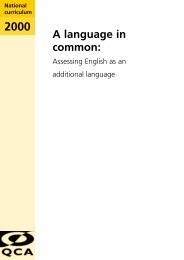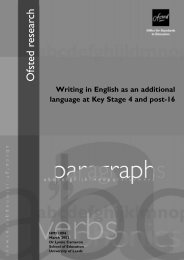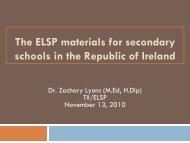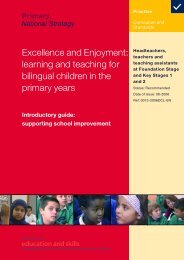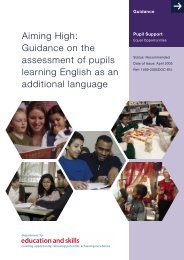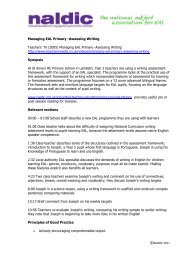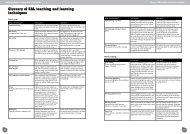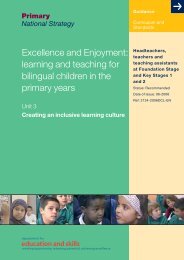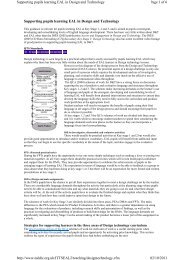Developing a language therapy package to meet the ... - NALDIC
Developing a language therapy package to meet the ... - NALDIC
Developing a language therapy package to meet the ... - NALDIC
Create successful ePaper yourself
Turn your PDF publications into a flip-book with our unique Google optimized e-Paper software.
Building Early Sentences (BESt):Designing bilingual <strong>language</strong> interventions<strong>NALDIC</strong>The Clothworkers’ Centenary ConcertHall, University of LeedsSaturday 26 th November 2011Dr Sean PertPrincipal Speech and Language Therapist
IntroductionThe role of <strong>the</strong> SLT and <strong>language</strong> <strong><strong>the</strong>rapy</strong>
5The role of <strong>the</strong> SLT: Language impairment• Language impairment is defined as ?• Language delay – ‘Children who are slow <strong>to</strong> talk’ – ‘…use of <strong>the</strong> term<strong>language</strong> delay is avoided in favor of <strong>language</strong> disorders’• Hegde and Maul 2006: 45• SLI ‘…children who show a significant limitation on <strong>language</strong> ability,yet <strong>the</strong> fac<strong>to</strong>rs usually accompanying <strong>language</strong> learning problemssuchas hearing impairment, low non-verbal intelligence scores, andneurological damage-are not evident• Leonard 1998: 3’Dr Sean Pert: <strong>NALDIC</strong> Conference 19, 26/11/11
7The role of <strong>the</strong> SLT: Language impairment• A child with a typically developing home <strong>language</strong> but pooradditional <strong>language</strong> learning requires more time and exposurein <strong>the</strong> additional <strong>language</strong> (EAL specialist required)• A child with poor/unusual <strong>language</strong> development in <strong>the</strong>ir home<strong>language</strong> and <strong>the</strong>ir additional <strong>language</strong> is likely <strong>to</strong> have a<strong>language</strong> impairment (SLT specialist required).Dr Sean Pert: <strong>NALDIC</strong> Conference 19, 26/11/11
8The role of <strong>the</strong> SLT: Language impairment• Language delay is a common diagnosis• It is problematic as ‘delay’ compares <strong>the</strong> child with <strong>the</strong>ir peers• It is unfair <strong>to</strong> compare a bilingual child with <strong>the</strong>ir monolingualpeers when using standardised assessments• Language delay and EAL acquisition may look similarDr Sean Pert: <strong>NALDIC</strong> Conference 19, 26/11/11
9The role of <strong>the</strong> SLT: differentiating• How <strong>to</strong> differentiate:• Language delay• Language disorder• EAL• Assess <strong>the</strong> child in both/all <strong>the</strong>ir <strong>language</strong>s• Observe <strong>the</strong>ir <strong>language</strong> learning over timeDr Sean Pert: <strong>NALDIC</strong> Conference 19, 26/11/11
12Language <strong><strong>the</strong>rapy</strong>: Impact• Language <strong><strong>the</strong>rapy</strong> may be restricted by commissioners <strong>to</strong> <strong>the</strong> ‘targeted’workforce• Children’s SLT services may withdraw from direct <strong>language</strong> <strong><strong>the</strong>rapy</strong>,providing only advice and ‘consultation’• The assumptions are that:• children will ‘catch-up’• <strong>language</strong> <strong><strong>the</strong>rapy</strong> is ineffectiveDr Sean Pert: <strong>NALDIC</strong> Conference 19, 26/11/11
The service in Heywood,Middle<strong>to</strong>n and RochdaleReality of Children’s SLT
14Referrals• 1000+ new referrals a year• Short term pathway• Long term pathway• Specialists• Approximately 800-900 referrals for <strong>the</strong> short term pathway• Impact of Sure Start fundingDr Sean Pert: <strong>NALDIC</strong> Conference 19, 26/11/11
15Staffing• 5.2 wte SLTs and 0.9 SLTAs monolingual service• 2.1 wte SLTs and 2.4 SLTAs bilingual service• SLTAs run 2-3 groups for 3-6 children each session• SLTAs speak Pakistani heritage <strong>language</strong>s: Mirpuri,Punjabi and Urdu• 1 Sylheti Bangla SLTADr Sean Pert: <strong>NALDIC</strong> Conference 19, 26/11/11
16Mirpuri• A Pakistani heritage <strong>language</strong>• Syntax contrasts with English• Morphologically rich verb structure• No determiners• Spoken and pre-literate <strong>language</strong>• Third most spoken <strong>language</strong> in <strong>the</strong> UK after English and Welsh• Often mistakenly called Urdu or PunjabiDr Sean Pert: <strong>NALDIC</strong> Conference 19, 26/11/11
17Mirpuri• Low status <strong>language</strong>• Often exists as a code-switched form, with code switchingtypical in adults and children incorporating elements fromEnglish, Punjabi and Urdu• Borrowings, e.g. apil, cup, plate etc• Basic form is AGENT + PATIENT + ACTION• Kuri kela kha-ni pi - Girl banana eat-ing+female is+femaleDr Sean Pert: <strong>NALDIC</strong> Conference 19, 26/11/11
18English• English is a morphologically impoverished <strong>language</strong>• Few gender agreements• Simplification of <strong>the</strong> <strong>language</strong> structures make it difficultfor children <strong>to</strong> decide what is a noun or a verb• High frequency verbs are often irregular, e.g. eat/ate• Therapy should ‘…avoid telegraphic speech, alwayspresenting grammatical models in well-formed phrase andsentences’ (Fey et al. 20003)Dr Sean Pert: <strong>NALDIC</strong> Conference 19, 26/11/11
Collaboration with NewcastleUniversityApplying <strong>the</strong> <strong>the</strong>ory, ga<strong>the</strong>ring <strong>the</strong> evidence
20Video case studies• Central Rochdale clinic 5 minutes from <strong>the</strong> <strong>to</strong>wn centre• Individual and group <strong><strong>the</strong>rapy</strong> offered• Mo<strong>the</strong>r <strong>to</strong>ngue input in offered by SLT with bilingual SLTAs in:• English• Pakistani heritage <strong>language</strong>s - Mirpuri / Punjabi / Urdu• Bangla (Sylheti/Standard)• O<strong>the</strong>r <strong>language</strong>s via interpreters• BESt taps in<strong>to</strong> <strong>the</strong> child’s <strong>language</strong> learning so should beapplicable <strong>to</strong> any <strong>language</strong>Dr Sean Pert: <strong>NALDIC</strong> Conference 19, 26/11/11
21The BESt <strong>language</strong> <strong><strong>the</strong>rapy</strong> programme• Based on constructivist <strong>the</strong>ory:• ‘…children learn strings of <strong>language</strong> directly from <strong>the</strong> input’• ‘All accounts of inflection assume, in one way or ano<strong>the</strong>r, that children cangeneralize across forms such as play-s, walk-s and run-s <strong>to</strong> form a VERB-s rule orscheme’• ‘…children learn lexical strings…e.g. He’s playing; He’s running) directly from <strong>the</strong>input, and abstract across <strong>the</strong>m <strong>to</strong> form lexically specific schemas (e.g. He’s X-ing).’Dr Sean Pert: <strong>NALDIC</strong> Conference 19, 26/11/11
22The BESt <strong>language</strong> <strong><strong>the</strong>rapy</strong> programme• ‘Experimental evidence that children repeat forms recently produced byadults…found that children were more likely <strong>to</strong> produce a correct 3sg (e.g. goes asopposed <strong>to</strong> go) when it had been recently produced by <strong>the</strong> experimenter.• Ambridge and Lieven 2011• Children use <strong>the</strong>ir general intelligence <strong>to</strong> find patterns and learn exceptions• Children learn from <strong>the</strong> <strong>language</strong> input <strong>the</strong>y receive• Children <strong>the</strong>n make schemas abstracted from <strong>the</strong> input using <strong>the</strong>ir ability <strong>to</strong> spotpatternsDr Sean Pert: <strong>NALDIC</strong> Conference 19, 26/11/11
23The BESt <strong>language</strong> <strong><strong>the</strong>rapy</strong> programme• The BESt is aimed at children with little or no expressive <strong>language</strong>• Comprehension skills are not targeted as is thought that <strong>the</strong> children willacquire meaning as <strong>the</strong>y acquire expression (in contrast <strong>to</strong> o<strong>the</strong>r <strong>language</strong>programmes)• Language is not simplified as <strong>the</strong> patterns help <strong>the</strong> child <strong>to</strong> abstract <strong>the</strong>schemas, e.g. a determiner helps <strong>to</strong> identify a noun, an auxiliary is followedby a lexical verb etc.Dr Sean Pert: <strong>NALDIC</strong> Conference 19, 26/11/11
24The BESt <strong>language</strong> <strong><strong>the</strong>rapy</strong> programme• Toys are used and actions acted out for children <strong>to</strong> see• The target sentences are said by <strong>the</strong> <strong>the</strong>rapist at <strong>the</strong> same time <strong>the</strong> action ishappening• The child does not have <strong>to</strong> repeat, just listen and observe• The child is <strong>the</strong>n shown / helped <strong>to</strong> act out a series of actions that have <strong>the</strong>same syntactic and morphological construction• One element is changedDr Sean Pert: <strong>NALDIC</strong> Conference 19, 26/11/11
25The BESt <strong>language</strong> <strong><strong>the</strong>rapy</strong> programmeDr Sean Pert: <strong>NALDIC</strong> Conference 19, 26/11/11
26The BESt <strong>language</strong> <strong><strong>the</strong>rapy</strong> programmeDr Sean Pert: <strong>NALDIC</strong> Conference 19, 26/11/11
27The BESt <strong>language</strong> <strong><strong>the</strong>rapy</strong> programmeDr Sean Pert: <strong>NALDIC</strong> Conference 19, 26/11/11
28The BESt <strong>language</strong> <strong><strong>the</strong>rapy</strong> programmeDr Sean Pert: <strong>NALDIC</strong> Conference 19, 26/11/11
29The BESt <strong>language</strong> <strong><strong>the</strong>rapy</strong> programme• There are common errors in English speaking children and Mirpuri speakingchildren:• Both sets of children• Omit <strong>the</strong> AGENT• Omit auxiliary verbs• Use non-verbal gestures or act out VERBS <strong>the</strong>y don’t know/can’t recall• Use ‘boy’ for both ‘man’ and ‘boy’ and ‘girl’ for both ‘girl’ and ‘lady’/’woman’• Make syntactic errors (phrase order) – rareDr Sean Pert: <strong>NALDIC</strong> Conference 19, 26/11/11
30The BESt <strong>language</strong> <strong><strong>the</strong>rapy</strong> programme• In addition, English speaking children• Omit determiners• Omit <strong>the</strong> present progressive –ing• In addition, Mirpuri speaking children• Use male gender agreement for all AGENTS on <strong>the</strong> present progressive and <strong>the</strong>auxiliary (N.B. cannot omit as gender inflection is required)• Code switch nouns• Code switch verbsDr Sean Pert: <strong>NALDIC</strong> Conference 19, 26/11/11
32The BESt <strong>language</strong> <strong><strong>the</strong>rapy</strong> programmeVideo of a child taking part in a BESt session• Reason for referral: 'Mum has concerns about speech sounds and puttingsentences <strong>to</strong>ge<strong>the</strong>r' - nursery teacher. Mum concerns about hearing.• Seen September this year for assessment aged 4 years 5 months• Dad speak Mirpuri, Mum both Mirpuri and EnglishDr Sean Pert: <strong>NALDIC</strong> Conference 19, 26/11/11
33The BESt <strong>language</strong> <strong><strong>the</strong>rapy</strong> programmeVideo of a child taking part in a BESt session• DLS-RST passed:• single word nouns• Single word verbs• 2WL• Not able <strong>to</strong> demonstrate understanding of longer and more complex instructions• Used no AGENTS, Mainly two word utterances• Some gaps in VERB vocabularyDr Sean Pert: <strong>NALDIC</strong> Conference 19, 26/11/11
34The BESt <strong>language</strong> <strong><strong>the</strong>rapy</strong> programmeVideo of a child taking part in a BESt session•Session 4 of <strong>the</strong> BESt <strong>language</strong>programme•VIDEODr Sean Pert: <strong>NALDIC</strong> Conference 19, 26/11/11
35The BESt <strong>language</strong> <strong><strong>the</strong>rapy</strong> programme•Now using a range of AGENTS•Longer utterances - full sentences•Self-correcting errors•More confident speakerDr Sean Pert: <strong>NALDIC</strong> Conference 19, 26/11/11
36The BESt <strong>language</strong> <strong><strong>the</strong>rapy</strong> programme• Preliminary results• Diagnostic <strong><strong>the</strong>rapy</strong> – children with poor exposure <strong>to</strong><strong>language</strong> input develop quickly• Some children have eliminated jargon• Most children have generalised <strong>to</strong> real situationsDr Sean Pert: <strong>NALDIC</strong> Conference 19, 26/11/11
37The BESt <strong>language</strong> <strong><strong>the</strong>rapy</strong> programme• Preliminary results• Increase in content• Increase in grammar and morphology• Increase in MLU• Increase in <strong>the</strong> consistency of useDr Sean Pert: <strong>NALDIC</strong> Conference 19, 26/11/11
38The BESt <strong>language</strong> <strong><strong>the</strong>rapy</strong> programme• Preliminary results• The non-verbal fine mo<strong>to</strong>r development assessment(VMI) did not show <strong>the</strong> same increase• Suggests an effect beyond simple maturationDr Sean Pert: <strong>NALDIC</strong> Conference 19, 26/11/11
39The BESt <strong>language</strong> <strong><strong>the</strong>rapy</strong> programme• Preliminary results• Cross linguistic – works on <strong>language</strong>s o<strong>the</strong>r thanEnglish• Face validity• Parents and SLTs can see changeDr Sean Pert: <strong>NALDIC</strong> Conference 19, 26/11/11
40References• Cirrin, F. M., & Gillam, R. B. (2008). Language intervention practices for school-age children with spoken<strong>language</strong> disorders: A systematic review. Language Speech And Hearing Services In Schools, 39, S110-S137.• Fey, M. E., Cleave, P. L., & Long, S. H. (1997). Two models of grammar facilitation in children with <strong>language</strong>impairments: Phase 2. Journal of Speech Language and Hearing Research, 40(1), 5-9.• Glogowska, M., Rouls<strong>to</strong>ne, S., Enderby, P., & Peters, T. J. 2000, "Randomised controlled trial of communitybased speech and <strong>language</strong> <strong><strong>the</strong>rapy</strong> in preschool children", British Medical Journal (Clinical research ed.),321, 7266, 923-926.• Hegde, M.N. and Maul, C.A., 2006. Language disorders in children: an evidence-based approach <strong>to</strong>assessment and treatment. (Bos<strong>to</strong>n MA: Pearson Education, Inc.)• Leonard, L.B., 1998. Children with Specific Language Impairment. (London: The MIT Press)• Royal College of Speech and Language Therapists, 2006. Communicating Quality 3: RCSLT's guidance on bestpractice in service organisation and provision. (London: RCSLT).Dr Sean Pert: <strong>NALDIC</strong> Conference 19, 26/11/11
41• © Dr Cristina McKean 1 and Dr Sean Pert 2• 1 Newcastle University• 2 Pennine Care NHS Foundation Trust, Heywood, Middle<strong>to</strong>n and RochdaleCommunity Healthcare• cristina.mckean@newcastle.ac.uk• S.Pert@NHS.netDr Sean Pert: <strong>NALDIC</strong> Conference 19, 26/11/11




